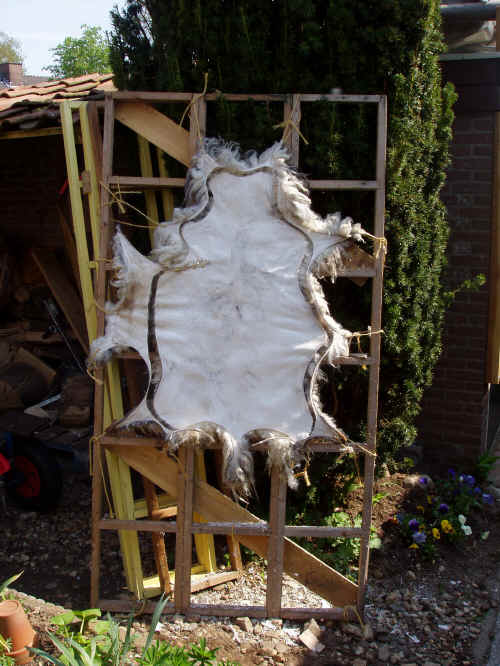Tanning with brains
By tanning the proteins in the skin are made insoluble.
The simplest primitive method of tanning is with the brains of the animal. Also urine (rich in ammonia) was used in order to prevent putrefaction.
The moist skin is placed in a bath of water containing dissolved brains and allowed to stand overnight. In the absence of cockpit you can rub the damp skin with brains and lay it rolled up in the shade. The next day, the skin is very firmly wrung out and goes a few times half an hour back in the tub. The wringing between the baths ensures that the in the water dissolved oil will be pressed deep in the skin. Then, the skin may dry up until he only feels cold but seems dry.

Tanning with tannin
Tannins fix protein. Except in tea and wine, they sit in oak, willow, pine and chestnut. Younger trees contain more tannin than old. Oak bark from seven to ten years is the best tanning. Tan is the dried bark of the oak. The bark is dried and ground so that the tannins are more easily pulled out. Milled and added to water it is called tannin solution. The right amount of bark to tan a skin is approximately equal to the weight of the moist skin (without hair).
Too little tannin means insufficient tanning. This is readily apparent because the tannin bath starts to stink a bit. You must add tannin.
Too much tanning causes the outer layers of the skin to be tanned, but also lock the deeper access to treatment. You can see this by cutting the skin. You see three layers like plywood: the tannin bath is too strong.
You need to soak skins and bark underwater so you can stir them at least once every day. Small hides such as those of rabbit or muskrat, are ready depending on the temperature, after one or two weeks. Larger skins take longer. A rawhide may be more than nine months to do.
At temperatures below ten degrees Celsius the tanning process comes to a halt.
Lukewarm water extracts more tannins to bark than cold water.
With bark tanned leather is harder, and therefore more suitable for e.g. shoe soles. With fat tanned leather is softer and better for gloves, shammy, clothing.
I found ca.80 anecdotes about leather human skin. Books bound in human skin are listed as a anthropodermic bibliopegy. Mr. Villenave possessed a copy of the 'Human Rights' [!] bound in this material. Forensic reports of murderers were sometimes bound in their own skin. The famous "Justine" by the Marquis de Sade was sometimes bound in female skin. With a preference for those of the breasts.
Morocco is also a kind of fine goatskin from Morocco. One author described it as the skin of a Moroccan Negro.
Descriptions range from calf over pigs to goatskin. And from rough, to soft and shiny.
The Duke of Orleans (Egalite) had one pants of human skin. For this, good and intact bodies of the condemned were skinned. (Histoire de Mont Gaillard)
Tattoos sometimes serve as decorative motifs. Stories about lampshades of tanned human skin from concentration camps (WWII) are also known. And nowadays there are skin donated before death (for use later). You can find out more about it with the term Human leather.
Besides, even skin of fish and ostrich are tanned into leather. And snake, crocodile ...
Smoothing or rolling
The next step is to stretch the skin and then keep it constant in motion while it dries. Otherwise, he is hard and stiff. You can use a wide, flat, rounded stick, firmly roll it over the stretched skin (smoothing). Or pulling every corner of the leather over the smooth head of a pole back and forth.
